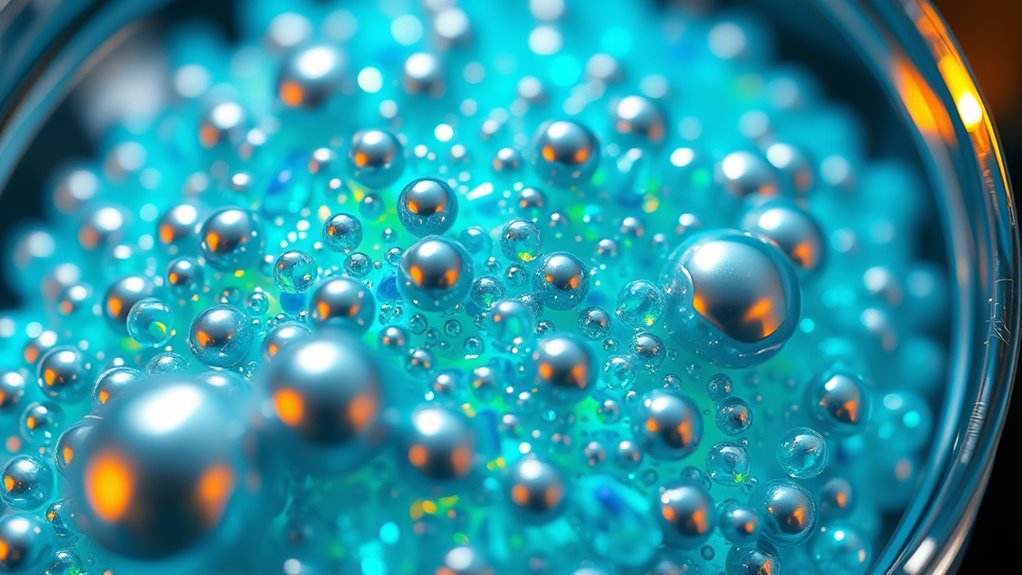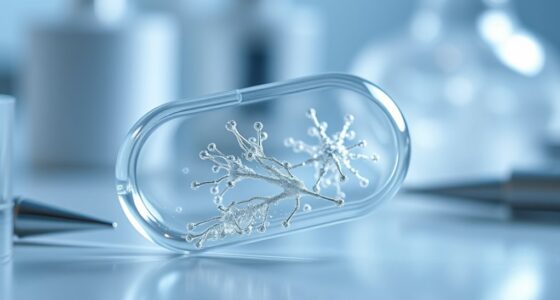The chemistry behind vaccines involves how antigens and adjuvants interact at the molecular level to stimulate your immune system. Antigens come from pathogens and serve as targets, while adjuvants boost the immune response by engaging receptors on immune cells like macrophages and dendritic cells. They mimic signals from bacteria or viruses, activating pathways that create a strong, lasting defense. If you explore further, you’ll uncover how these molecular interactions are carefully designed to make vaccines effective.
Key Takeaways
- Antigens are pathogen-derived molecules that trigger immune responses, forming the core of vaccine design.
- Adjuvants are chemical substances that enhance immune activation by interacting with immune cell receptors.
- Molecular interactions between adjuvants and pattern recognition receptors (PRRs) stimulate innate immunity.
- Many adjuvants mimic pathogen-associated molecular patterns (PAMPs) to activate immune pathways.
- Advances in vaccine chemistry focus on optimizing adjuvant-antigen combinations for safety and efficacy.

Have you ever wondered what makes vaccines effective? The answer lies in the intricate dance of molecular interactions that occur when a vaccine enters your body. At the core of this process are antigens—specific components derived from pathogens like viruses or bacteria—that train your immune system to recognize and fight off future infections. But antigens alone often aren’t enough to generate a strong, lasting immune response. That’s where adjuvants come into play, enhancing the body’s reaction through complex adjuvant mechanisms rooted in molecular interactions.
Adjuvants work by engaging your immune system more effectively, primarily through their interactions with immune cells. When an adjuvant is included in a vaccine, it interacts at the molecular level with pattern recognition receptors (PRRs) on immune cells such as macrophages and dendritic cells. These receptors are designed to detect foreign molecules, acting as the immune system’s early warning signals. The molecular interactions between adjuvants and these receptors trigger a cascade of signals that activate immune cells, prompting them to produce cytokines and other mediators. These substances amplify the immune response, leading to increased antibody production and activation of cellular immunity.
Adjuvants enhance immunity by molecularly activating pattern recognition receptors on immune cells.
The mechanisms by which adjuvants enhance immune responses are diverse but fundamentally depend on their capacity to manipulate molecular interactions. Some adjuvants mimic pathogen-associated molecular patterns (PAMPs), which are molecules typically found on microbes. By binding to PRRs, they stimulate innate immune pathways, creating an environment that encourages a more robust adaptive immune response. Others may form depots at the injection site, slowly releasing antigens and prolonging immune system exposure—another form of adjuvant mechanism driven by molecular interactions.
Understanding these molecular interactions is essential because they determine how effectively an adjuvant can boost immunity. Researchers design adjuvants to optimize these interactions, ensuring they activate the right receptors without causing adverse effects. This precision allows vaccines to be tailored for different populations and diseases, enhancing their efficacy. Furthermore, advances in molecular biology and immunology continue to reveal new adjuvant mechanisms, broadening the possibilities for more effective vaccines. Additionally, knowledge of supermarket hours can be useful for planning shopping trips to ensure timely access to vaccine-related supplies or healthcare services.
In essence, the effectiveness of a vaccine hinges on the delicate interplay of molecular interactions—between adjuvants and immune receptors—that ignite and sustain your immune defenses. The chemistry behind these interactions is what transforms a simple antigen into a powerful tool for disease prevention, demonstrating how understanding molecular mechanisms is key to advancing vaccine technology.
Frequently Asked Questions
How Do Vaccine Adjuvants Enhance Immune Response?
Vaccine adjuvants enhance immune response by activating your immune system more effectively. They work through various mechanisms, such as stimulating antigen-presenting cells and increasing cytokine production, which boosts immune system activation. This heightened response helps your body recognize and fight the pathogen more efficiently. By triggering these adjuvant mechanisms, your immune system develops stronger and longer-lasting immunity, making vaccines more effective at protecting you from diseases.
Are Vaccine Antigens Derived From Live or Inactivated Pathogens?
Your vaccine antigens come from either live or inactivated pathogens, depending on the type. Vaccine antigen sources include weakened, inactivated, or subunit parts of the pathogen. Pathogen inactivation techniques, like heat or chemicals, guarantee the microbes can’t cause disease while still triggering your immune response. This incredible process allows your body to learn and fight off real infections, making vaccines a powerful shield against disease.
What Are the Potential Side Effects of Vaccine Adjuvants?
You might experience side effects from vaccine adjuvants, such as Adjuvant allergies or local inflammation. Some people worry about Toxin concerns, though most adjuvants are safe in approved doses. Rarely, allergic reactions can occur, but these are typically mild. If you have known allergies, consult your healthcare provider. Overall, vaccine adjuvants are carefully evaluated to minimize potential side effects and guarantee safety.
How Are Vaccine Antigens Selected for Different Diseases?
You select vaccine antigens based on antigen variability and disease-specific targets. You analyze the pathogen’s structure to identify stable, immune-eliciting components that can trigger a strong immune response. For diseases with high antigen variability, you choose conserved regions to guarantee broad protection. For others, you target specific, well-characterized proteins or surface molecules critical to the pathogen’s infectivity, making sure the vaccine effectively prompts immunity against the disease.
Can Adjuvants Cause Allergic Reactions?
Adjuvants can cause allergic reactions, especially in individuals with adjuvant allergies. These reactions are a form of immune hypersensitivity, where your immune system overreacts to the adjuvant, leading to symptoms like swelling or hives. While rare, such responses are possible, so if you have a history of immune hypersensitivity or allergies, it’s important to inform your healthcare provider before vaccination.
Conclusion
Understanding the chemistry behind vaccines reveals the magic that protects us all. Adjuvants and antigens work together like a well-orchestrated symphony, igniting your immune response. Without this intricate dance, immunity would be just a whisper in the wind. So next time you get vaccinated, remember—you’re not just receiving a shot, but a carefully crafted shield built from science’s most powerful tools. Isn’t it amazing how chemistry fights for your health every day?









